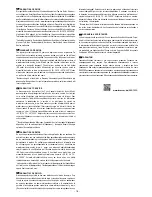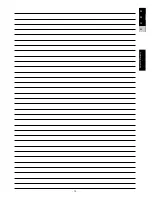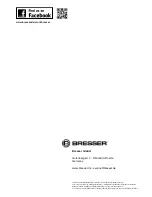
- 10 -
Scope of delivery:
• LCD touch microscope with slide clips and colour filter wheel
with pinhole apertures
• Two dissecting needle
• Pipette
• Tweezers
• MicroCut forceps
• Yeast, gum media, sea salt, shrimp eggs, shrimp hatchery
Box containing microscope slides, cover slips and permanent
specimens
• Mini USB connection cable
• Power supply
General/location
Select a suitable location before starting to set up your
microscope. First make sure that your microscope is standing
on a stable, vibration-free surface. In order to put the
microscope into operation, the power supply provided must
be connected to the microscope (Fig. 1, image 7/11) and a
230 V plug socket. The appropriate illumination is switched
on using the switch (Fig. 1, image 17/18), and the brightness
is controlled for optimum illumination of the specimen by
turning the selection wheel. (For safety reasons, please only
use the power supply provided. Other power supplies may
not meet the required technical specifications. Damage to the
device caused by other power supplies is not covered by the
guarantee.)
Electric LED illumination with dimmer
Transmitted light illumination (Fig. 1, image 6) is used for
transparent specimens (specimens on microscope slides).
Select incident light illumination (Fig. 2, image 15) to observe
opaque objects. The simultaneous use of transmitted
and incident light illumination is only advisable with semi-
transparent objects. This mode is not recommended for
transmitted light objects on slides since too much light may be
reflected on the slide.
Colour filter/aperture combi wheel
The colour filter/aperture combi wheel (Fig. 1, image 8) beneath
the microscope table can be used to influence the image
quality when observing transparent specimens. Fine details
are displayed better depending on the colour and object. A
coloured lower light in combination with a white upper light
can also optimise image details when observing objects under
incident light (e.g. transparent objects).
Depending on the aperture used, the corresponding light
bundling can also influence the sharpness, depth of field,
contrast and detail resolution during observation.
Observation
Turn the nosepiece (Fig. 1, image 3) to select the 4x objective
for observing objects. Depending on the object, select upper
or lower lighting for optimum illumination. Place a specimen
on the microscope table (Fig. 1, image 5) directly under the
objective and secure it using the slide clips (Fig. 2, image 16).
Important: The object to be observed must lie precisely in the
beam path of the transmitted light illumination. Now slowly
turn the focusing wheel (Fig. 2, image 10) until the image on
the monitor is reproduced sharply. The dimmers (Fig. 2, image
17) and (Fig. 2, image 18) can be used to optimally adjust
the contrast and quality of the image of the object under
observation.
Turn the nosepiece (Fig. 1, image 3) to switch objectives if
increased magnification is desired. Incidentally: The higher
the level of magnification, the more light is required for good
image quality.
Incident light illumination is optimised for the 4x objective. The
specimen is generally no longer fully illuminated if the 10x or
40x objective is used.
(H)
Capture a photo or start/stop video recording
(I)
Switch between photo capture and video recording
(J)
Basic program settings
(K)
Complete overview of captured images
(L)
Video recording active
(M)
Length of video recording
(N1) Enlarge image
(N2) Reduce image
(O)
Return to the overview
(P)
Confirm the selected setting
(Q1/Q2) Select image number
(R)
Indication of the selected image number
(S)
Yellow frame marks the selected image
(T)
No. of the image currently displayed on the monitor
(U1) Delete all images
(U2) Delete a single image marked with a yellow frame
(V)
Arrows for selecting the previous or next image
Note:
If no control elements are displayed, a light press on the
screen is sufficient to make all the basic control elements
reappear!
All parts (Fig. 1)
B
Monitor
C
Monitor on/off button
d
Revolving turret
E
Interchangeable objectives with varying magnification
F
Microscope table
g
LED transmitted light illumination
H
Power supply
i
Colour filter wheel with pinhole apertures
j
Storage compartment for small items
1)
Focusing wheel
1!
Rear power connection
All parts (Fig. 2)
1@
SD card slot, max. 32 GB
1#
Mini USB connection
1$
AV output
1%
LED incident light illumination
1^
Microscope slide clips
1&
On/off switch with integrated dimmer for
incident light illumination
1*
On/off switch with integrated dimmer for
transmitted light illumination
All parts (Fig. 3)
1(
Dissecting needles
2)
Pipette
2!
Tweezers
2@
MicroCut forceps
2#
Shrimp hatchery
2$
Yeast
2%
Gum media
2^
Sea salt
2&
Shrimp eggs
2*
Box containing microscope slides, cover slips and
permanent specimens
2(
Cross table (optional)
3)
Transverse adjusting screw
3!
Longitudinal adjusting screw
3@
Fastening screw




















